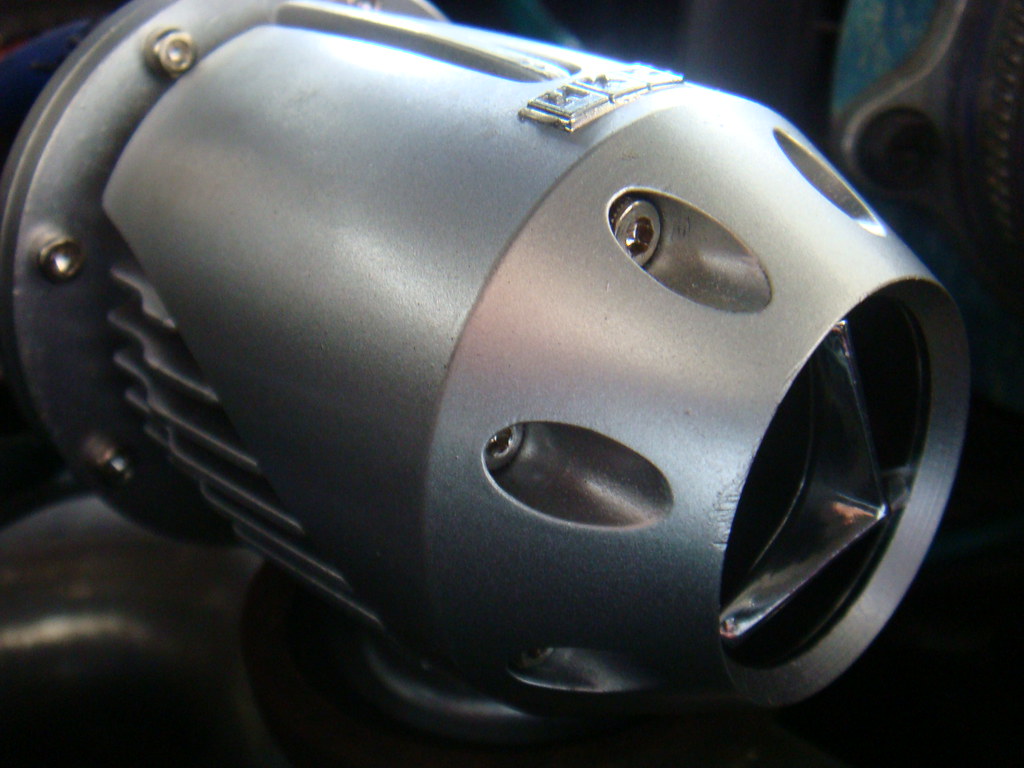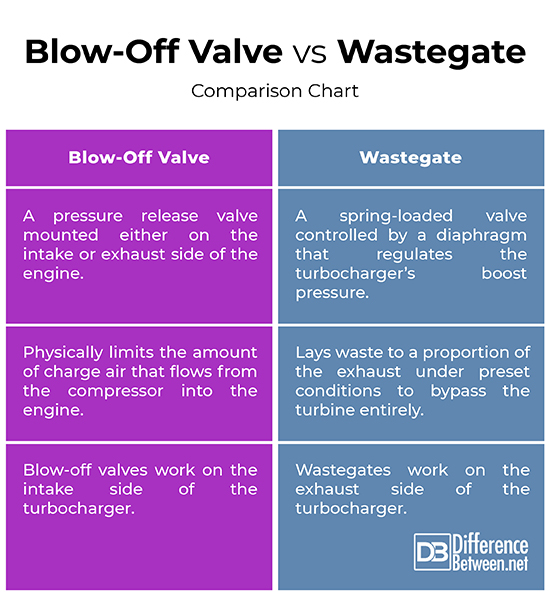Difference Between Blow-Off Valve and Wastegate
In a turbocharged vehicle, there are always multiple constraints that come into play to limit boost, even without any active boost controls. You remove one bottleneck in the turbo system and something else becomes the problem. The question is, can the structural components alone be enough to limit boost to a level the engine can live with? It’s important to understand how structural factors limit boost – but the goal has always been to make the system more efficient.
Boost control strategies rely on a variety of factors such as their effect on power, torque, thermal efficiency, fuel economy, turbo longevity, and so forth. Generally speaking, the boost control mechanics typically fall into two categories: physically limiting the amount of charge air that flows from the compressor into the engine by installing blow-off valves or controlling the flow of exhaust gases to the turbine wheel by wasting a portion of exhaust under specific conditions so that it bypasses the turbine entirely.

What is a Blow-Off Valve?
A blow-off valve or pressure control valve is a pressure release device used on most turbocharged engines to increase the life of the turbocharger by limiting the surge against the compressor and bearings from sudden throttle closure. Although, the sound made by the turbo surge may seem incredible, it’s actually not so good for the mechanicals. When you’re hard on the throttle and you hit boost, pressure starts building up in those charge pipes. Once you snap the throttle shut, that charge has nowhere to go.
Basically, what happens is while the pressure is building, the air is coming out of the turbo that’s supposed to go the engine and all the pressure that is already built up forces its way back to the turbo which causes what we call the compressor surge. A blow-off valve is simply a diverting mechanism that creates a passage for the compressed air charge to escape into the atmosphere in order to keep the surge out of the turbo.

What is a Wastegate?
The turbocharger can raise boost pressure so high that can damage the engine. To limit the boost pressure and prevent overboost, most turbochargers have a valve that regulates the boost pressure by controlling and limiting the speed of the turbine. Wastegate is a dynamic boost control device used on modern turbocharged engines to control the speed of the turbine by diverting the exhaust around the turbine when boost pressure reaches a preset maximum value. Wastegate is a simply a bypass valve that helps exhaust gases to bypass the turbine and just go straight out of the car in order to protect the engine and the turbocharger.
A wastegate is installed in the exhaust system upstream of the turbine wheel that regulates exhaust energy by allowing a proportion of the exhaust gas to bypass the turbine entirely. There are typically two types of wastegates used on turbocharged engines: internal and external wastegate. Most factory turbo cars come with an internal wastegate which are actually built into the turbo exhaust housing directly for ease of installation and cost efficiency. An external wastegate is a standalone self-contained mechanism that comes to use when an internal wastegate is not able to keep up, especially when making large amounts of horsepower.
Difference between Blow-Off Valve and Wastegate
Mechanism
– The common problem with modern turbocharged engines is compressor surge which not only affects the turbo response but also messes with the drivability of the car. There are typically two ways to deal with a compressor surge – blow-off valves and wastegates. A blow-off valve is simply a pressure release device mounted either on the intake or exhaust side of the engine that allows the pressurized air inside the intake piping to escape into the atmosphere. A wastegate, on the other hand, is a popular boost control mechanism that diverts the exhaust around the turbine when boost pressure reaches a preset maximum value.
Working
– A blow-off valve physically limits the amount of charge air that flows from the compressor into the engine by creating a passage for the compressed air charge to vent off before it reverts back to the turbo and puts a burden on the compressor wheel. The valve opens when a certain pressure level is achieved when engine speed changes abruptly. A wastegate is a spring-loaded valve controlled by a diaphragm; exhaust gas pressure is fed to one side of the diaphragm, while the intake manifold pressure is fed to the other side. When the desired boost level is reached, the valve opens and makes the exhaust gases bypass the turbine wheel.
Blow-Off Valve vs. Wastegate: Comparison Chart

Summary
The biggest problem with a bypass valve system is that it cannot flow enough air for high horsepower applications. A blow-off valve is best used as an absolute boost-limiting device to control the boost pressure when the exhaust gas pressure exceeds a set limit. However, they have limited applications for production engines or in the aftermarket. A wastegate works by bleeding exhaust gases past the turbine wheel when the pressure differential reaches a set point. The exhaust gas is wasted because it does not help spin the turbine. A blow-off valve is a simpler way to control turbocharger boost.
- Difference Between Caucus and Primary - June 18, 2024
- Difference Between PPO and POS - May 30, 2024
- Difference Between RFID and NFC - May 28, 2024
Search DifferenceBetween.net :
Leave a Response
References :
[0]Crouse, William Harry and Donald L. Anglin. Automotive Mechanics. New Delhi, India: Tata McGraw-Hill Publishing Company Limited, 2007. Print
[1]Miller, Jay K. Turbo: Real World High-Performance Turbocharger Systems. Minnesota, United States: CarTech Inc., 2008. Print
[2]Hartman, Jeff. Turbocharging Performance Handbook. Minnesota, United States: Motorbooks, 2007. Print
[3]Watson, Ben. Diesel Performance Handbook for Pickups and SUVs. Minnesota, United States: Motorbooks, 2008. Print
[4]Kojima, Mike. Honda/Acura Engine Performance: How to Modify D, B and H Series Honda/Acura Engines for Street and Drag Racing Performance. New York, United States: Berkley Publishing Group, 2002. Print
[5]Image credit: https://commons.wikimedia.org/wiki/File:Wastegate-Lader.jpg
[6]Image credit: https://live.staticflickr.com/2138/2469917475_c312dc7edd_b.jpg
